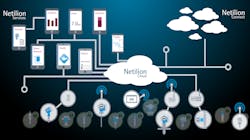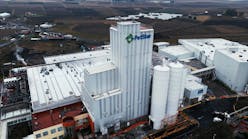Industrial wastewater treatment is a challenge for many process manufacturers because effectively removing contaminants and keeping chemical properties within allowable specifications is of paramount importance for environmental and human safety. Reusing wastewater in secondary capacities can alleviate some of the treatment burden, but when this is not feasible, discharge to a sewer system or the environment is the only other option. Strict regulations, along with increasing internal sustainability initiatives, can make treating wastewater a costly and complex task.
Depending on the industry or locale, and the contaminants within the wastewater, there are a number of characteristics that may be regulated. Alongside classic properties like pH and turbidity, phosphate limitations are quickly taking hold in North America, requiring processors to maintain appropriate instrumentation for monitoring phosphorus levels in their discharge.
A phosphorus problem
Over the past three decades in the United States, a new understanding of the ecological harm caused by excess phosphorus in water supplies has led to strict regulatory restrictions on its allowed concentration in facility wastewater discharge. Though nontoxic by itself, this element spurs plant and algae growth in aquatic ecosystems to levels where they can quickly become invasive, starving the water of oxygen and crowding out other organisms.
When this occurs, it leads to an imbalance of nutrients — a condition known as eutrophication — which negatively impacts natural order in lakes and rivers, and in turn adversely affects food supply chains. The lack of dissolved oxygen kills aquatic life, and the algae can release toxins that are harmful to humans as well.
The primary reason for treatment is to protect downstream waters, and most discharge ultimately ends up in rivers or lakes (Figure 1), which is why standards stipulate strict limits on the amount of phosphorus in treated wastewater.
The increased focus on reuse in the water/wastewater industry is not merely limited to water, but it also extends to recapturing nutrients, such as phosphorus. Collecting phosphorus in wastewater has dual benefits, simultaneously keeping it out of process plant discharge, where it is destructive to ecosystems, while capturing it for use as premium fertilizer for use in agriculture.
Calibration challenges
Maintaining the proper instrumentation to monitor phosphorus levels and other properties of wastewater is not always simple. Conventional instrumentation, for example, requires regular calibration to ensure accurate measurement, an activity that can be wrought with difficulties, threatening around-the-clock operation in manufacturing environments.
Calibrations were historically performed routinely, requiring removal of analytical instruments from service at predetermined intervals to test, verify and record settings, and then reconfigure instruments if necessary to maintain measurement reliability. During this offline calibration, maintenance personnel used analog communication methods to perform testing, and they needed to ensure wiring connections did not get wet, a challenge when dealing with wastewater.
Modern smart instruments, however, include several native tools for extending calibration intervals, including online in-situ verification, automatic calibration reporting and advanced instrument diagnostics (Figure 2).
These built-in diagnostics continuously monitor instrument health, and alerts can be configured to trigger as components degrade or measurements drift. The summation of these enhancements can even alleviate the need to calibrate at a predetermined frequency, laying the foundation for predictive maintenance with proactive calibrations only when deemed beneficial based on instrument and process conditions.
Advanced diagnostics, Memosens technology enhance analytical instrumentation
In conjunction with online diagnostics and verification, Memosens technology is revolutionizing industrial liquid analysis with devices that convert measured analog values into digital signals and transfer them inductively to a transmitter, eliminating problems associated with moisture and other factors. Memosens provides reliable information transfer, with signal alarms in the event of data disruption.
Memosens instruments include onboard storage for calibration, sensor information and process data, facilitating trend identification for efficient process management and predictive maintenance. The lack of contact required to relay measurements from probe to transmitter eliminates the effects of moisture, corrosion and salt bridges, and galvanic isolation ensures interference-free measurement and safe electromagnetic compatibility.
With pre-calibrated sensor heads, onsite sensor exchange time is minimized, reducing process downtime. These instruments can be used in hazardous areas, and they include a multitude of sensor heads that can be matched to transmitters with various safety ratings. Unlike pH and turbidity, Memosens technology is not inherent to phosphorus measurement. Rather, phosphorus measuring systems can employ Memosens connected devices and make use of other instrument enhancements to monitor diagnostic information.
For example, Endress+Hauser’s CA80 colorimetric analyzers — which can measure phosphorous levels — employ advanced diagnostics to monitor operating conditions like health of internal systems, absorption measurement quality, error events and other parameters that basic instruments cannot detect.
Connecting Memosens sensors to phosphorus measurement solutions in this way creates a system with additional features, known as Heartbeat Technology, to ensure optimal performance. Instrumentation with this technology is capable of automatic and in-situ device verification, saving records in local instrument storage without the need for external software or process interruptions. Verification not only confirms whether device components comply with original reference values, it can also detect the presence of systematic faults which negatively impact devices and processes over time if left unmitigated.
Each verification is traceable, and the results can be documented in compliance with industry best practices and relevant standards, like NAMUR NE 107. To transmit this information to an asset management or control system, users can leverage digital instrument protocols, including HART, WirelessHART, Bluetooth, IO-Link and EtherNet/IP. Along with diagnostic data, process information — such as water qualities, limit values, levels, temperature, pressure and physicochemical quality parameters — is also transmitted.
Phosphorus is removed from wastewater by adding precipitants, which can be dosed at various points. If the dosage is too high, it can increase wastewater salinity, producing a sludge byproduct. Excess salinity also increases the number of ions in the water, which in turn impacts the pH value and can ultimately lead to corrosion.
This situation has direct financial implications as well because precipitant is costly, and sludge drives disposal costs up. Therefore, optimizing precipitant dosage can lead to significant savings. The ideal level is reached when treated discharge reliably adheres close to limit values, and finding this balance can be automated with responsive monitoring and closed-loop control, which starts with reliable and accurate measurement of process parameters.
Instrumentation and software replacement in a food and beverage facility
A food and beverage processor struggling to maintain compliance with phosphorus discharge limits understood it needed to enhance its monitoring instrumentation. Its previous setup was unreliable and unwieldy, with each monthly calibration requiring a shutdown, interrupting operations for hours in the best cases.
After considering multiple potential alternatives, the processor decided to replace the old instrument with Endress+Hauser’s Liquiline CA80 analyzer (Figure 3). The instrument’s primary strengths for the processor were its embedded advanced diagnostic capabilities, efficient operation — requiring less reagent than competing products — and flexibility to monitor orthophosphate, ammonia and other water-soluble components.
The selected instrument incorporates a refrigeration system to cool its primary reagent, further extending this consumable’s useful life. Additionally, tubing and reagent maintenance are typically tool-free, and the analyzer’s modular layout makes replacing components simple in the event of any issues.
As regulatory requirements tighten across locales, accurate measurement must be ensured to greater extents. To address this and other issues, the processor’s analyzer includes two PID controllers for feedforward and feedback control, providing precise precipitant dosing to meticulously regulate orthophosphate levels.
The analyzer employs a digitally programmable photometer platform to operate over a range of wavelengths, comprised of LEDs with low degradation levels. This consequently reduces maintenance requirements over time.
Plant personnel leverage contextualized data, sourced from this analyzer and others using Endresss+Hauser’s Netilion software platform, to improve facility-wide maintenance management and decision-making (Figure 4).
The consolidated platform helped the processor automate tasks that were previously manual and inefficient, providing productivity gains and continuous reporting in real time, and empowering staff to:
- Efficiently monitor decentralized processes through comprehensive visualization of critical variables, reducing the frequency of manual equipment inspections.
- Access instrument and asset data independent of time and place, with visualization provided via web server capabilities. This allows any device capable of hosting a web browser — such as a laptop, smartphone or tablet — to securely access the data.
- Reduce operating costs with preemptive condition monitoring and anomaly detection, and with improved troubleshooting insights to get systems back online quickly in the event of failure.
- Analyze and visualize ratios, amounts, thresholds, time series and trends, as well as chemical balances.
The processor now remains in optimal compliance with discharge regulations, and it additionally benefits from these added insights to operate safely and make decisions quickly.
Innovate more, react less
As process manufacturers continue striving to innovate products for end user customers, maintaining wastewater monitoring instrumentation is one of the least desirable areas to spend valuable time and money. Modern instrumentation advances, like Memosens technology and advanced diagnostic capabilities, provide users with solutions to minimize maintenance requirements and process interruptions, while ensuring regulatory compliance through automated verification and alerting, with onboard recordkeeping to extend calibration intervals.
These enhancements help companies make the move from time- and cost-intensive scheduled-based to predictive maintenance — reducing configuration and operational downtime — while increasing data sharing, improving environmental stewardship and generating process insights to maximize throughput and profitability.
Nick Hanson is the Water & Wastewater Industry Marketing Manager for Endress+Hauser USA. In this role, he is responsible for strategic market planning and industry outreach events. As part of the Endress+Hauser Global Strategic Industry Group, he acts as the voice of the U.S. market to guide solutions specific to the region. Nick has a Bachelor of Science degree in Mechanical Engineering from the University of Colorado Boulder, and he has worked in the process instrumentation and control industry since 2012.
Endress+Hauser






